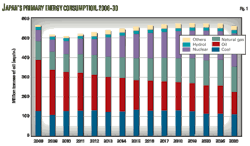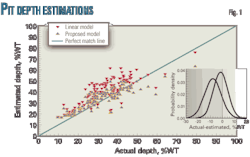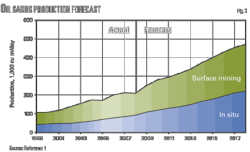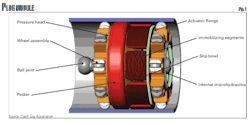GULF MARGINAL PRODUCTION—1: Reserves, revenues substantial in marginal Gulf of Mexico fields
Experts may disagree on when world oil production will peak, but there is general agreement that marginal fields will contribute a greater percentage of world supply in the future.
Each producing property is unique and has costs and benefits specific to each stage of its life cycle. As fields mature and operations transition into the later stages of their production cycle, decreasing revenue streams, higher operating costs, and fewer upside opportunities lead to declining profitability.
In this three-part series on marginal production in the Gulf of Mexico, we highlight the results of a recent Minerals Management Service study that estimated the marginal production and gross revenue streams associated with the inventory of producing structures circa January 2007.1
The cumulative hydrocarbon production from the inventory of producing assets is estimated to be 1.056 billion bbl of oil and 13.3 tcf of gas. Marginal production is expected to contribute 4.1% of the total oil production and 5.4% of gas production in the gulf.
In Part 1, we review historical production characteristics of the gulf.
OCS operations
The Outer Continental Shelf (OCS) of the Gulf of Mexico is the most extensively developed and mature offshore petroleum province in the world.
More than 46,000 wells have been drilled in the OCS since offshore production began in 1947, and about 6,500 producing wells, 3,800 structures, and 33,000 miles of pipeline are currently used in the production of oil and gas.
As of March 2009, there were 1,043 producing leases, 628 unitization agreements, and about 200 leases in suspension. In 2008, the Gulf of Mexico OCS produced more than 422 million bbl of oil and about 2.8 tcf of gas, roughly 25% and 13% of the US total.
Operating offshore is more complex and risky, and more capital intensive, than onshore environments. Offshore wells have higher operating costs than onshore wells and tend to be more sensitive to changes in market conditions.
Offshore production tends to be more chaotic, and smoothly declining profiles near the end of production are not common, exacerbating the difficulty associated with forecasting abandonment. Mature structures produce from a small number of wells, and if a problem arises, it may not be economic to perform a workover.
The application of secondary and enhanced oil recovery techniques is more complex and subject to constraints such as space and weight restrictions and high transportation and operating costs not found onshore. Secondary and tertiary recovery techniques that are commonly used to extend the production life of onshore assets are usually not economic offshore.
Defining marginal production
Production characteristics and profitability change during the life cycle of every structure.
Broadly speaking, the capital intensive expenditures associated with drilling wells and fabricating and installing infrastructure and equipment during the early years of a structure's life cycle are quickly replaced by revenue streams that recover the investment within a few years (Fig. 1).
There is nothing more profitable than an oil or gas well, and most structures start out highly profitable, but after peak production, profitability tends to decline as costs increase and revenue decreases. At some point near the end of a structure's life, revenues approach operating cost and the asset becomes marginally profitable.
As reservoir pressure declines, the cash flow generating ability of the structure is replaced by a decreasing revenue stream, higher operating costs, fewer upside opportunities, and eventually, production that is worth less than the cost to operate and maintain the structure. At the end of the commercial life of a structure, the structure is abandoned and decommissioned according to regulatory guidelines.
Marginal fields have different economics than large fields, require different recovery techniques, and are produced by smaller companies, usually proprietorships, partnerships, and limited liability companies. Production is still commercial (or "economic"), but the conditions under which a profit is generated tend to be more restricted.
Marginal wells are often considered to operate on the lower edge of profitability, but no single definition of what constitutes a marginal well exists (Fig. 2). The dark arrow in Fig. 2 indicates the time period when structures are considered to enter their marginal phase.
When does production turn marginal? Ideally, a marginal well should be defined with respect to profitability, or when the marginal cost of operation equals the marginal revenue of production, but because cost is generally unapparent to an outside observer, the practical application of this definition has significant shortfalls.
The next best alternative is to apply a threshold to operationalize the definition of marginal production. Onshore and in state waters, state and federal regulations typically define marginal production based on a producing threshold of 10-15 b/d of oil and-or 60-90 Mcfd of gas. In federal waters, the MMS defines a marginal well as producing less than 90 b/d or 540 Mcfd.
Active structure count
The number of active structures in the gulf is shown in Fig. 3.
Active structures represent the total number of structures that exist at any point in time and include both producing and nonproducing structures. In December 2006, there were 3,838 active structures: 2,324 fixed platforms, 380 well protectors, 1,091 caissons, and 43 "other" structures which includes deepwater floaters such as tension-leg platforms and spars.
The number of removals began to equal or exceed the number of installations in the early 1990s, and during this time, the inventory of active structures began to stabilize. The number of structures removed each year now exceeds the number of installations, and will likely continue in the future, as fewer new structures are installed on the shelf and a larger number of structures supporting marginal fields are abandoned.
Deepwater structures do not contribute materially to the structure count. The cumulative number of installed, removed, and active structures is shown in Fig. 4.
Producing structures
The number of structures producing hydrocarbons in the gulf is shown in Fig. 5 classified according to primary output.
A structure that produces any amount of oil or gas in the year of observation is said to be producing, and the producing gas-oil ratio (GOR) is used to classify structures as "oil" or "gas" producers. A structure with GOR <5,000 cu ft/bbl is labeled an oil structure and a gas structure corresponds to GOR >5,000 cu ft/bbl.
A producing structure may stop production for a period of time, perhaps due to hurricane damage or reservoir problems, temporarily reducing the producing structure count, only to reenter the inventory at a later time. Structures that are inactive for a few years, however, are unlikely to reenter the producing pool.
Gas structures began to outnumber oil structures in 1978 and currently represent about 65% of the total inventory of producing structures. The sharp decline in the number of producing structures in 2006 is due to the impact of the 2005 hurricane season: producing structures declined from 2,328 in 2005 to 2,017 in 2006. At the end of 2006, there were 813 oil producers and 1,204 gas producers in the gulf.
Nonproducing structures
The number of nonproducing structures is computed as the difference between the number of active and producing structures. Nonproducers include idle structures that once produced hydrocarbons as well as auxiliary structures that serve in a support role as a storage, compression, or metering facility and have never produced.
The number of nonproducing structures is shown in aggregate and as a percentage of the total number of active structures (Fig. 6). Interestingly, the number of idle structures has remained around 40% of the inventory for the last several decades. Before 1960, the percentage of nonproducers appears unusually high, but this may be due to reporting problems and-or other data integrity issues, or may simply be reflective of the immature state and small number of structures in the region at the time.
Production profiles
Oil production from oil structures and condensate production from gas structures is shown in Fig. 7 on an annual and cumulative basis.
Dry and associated gas production is shown in Fig. 8.
Oil structures produce the majority of liquid production with relatively small amounts of condensate contributed by gas structures. Oil structures produce a significant amount of associated gas, currently about a third of total gas production in the gulf.
Oil producers
The number of oil structures categorized by production group is shown in Fig. 9.
The number of oil structures across each production category has remained relatively stable over the past 2 decades.
Gas producers
The number of gas structures categorized according to daily gas production is shown in Figs. 12 and 13.
High producer groups constitute the majority of active gas structures and contribute more than 95% of total annual production and cumulative production. The contribution to cumulative gas production from low producers contributes less than 3%. While marginal producers account for about 4.6% of total active structures, their gas production is less than 0.1% on both an annual and cumulative basis (Fig. 15).
Next: The author introduces the model framework used to identify marginal structures and the level of their future production.
Reference
1. Kaiser, M.J., Yu, Y., and Pulsipher, A.G., "An assessment of marginal production in the Gulf of Mexico and lost production from early decommissioning," Center for Energy Studies, Louisiana State University, Baton Rouge, US Department of the Interior, Minerals Management Service, New Orleans, in review.
More Brand Name Current Issue Articles
More Brand Name Archives Issue Articles
View Oil and Gas Articles on PennEnergy.com









